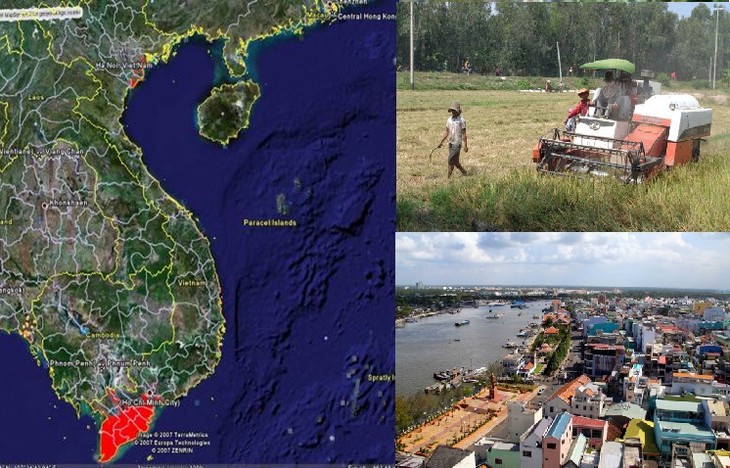(VOVWORLD) - After nearly 2 years of implementing a government resolution on sustainable and climate resilient development of the Mekong Delta, known as Resolution 120, a number of policies have been revised to enable the region’s comprehensive development. Ministries, agencies, and localities are working on a master plan on the region’s sustainable growth.
 Mekong Delta re-plans in response to climate change Mekong Delta re-plans in response to climate change |
Last year the Mekong Delta’s GDP growth rate reached 7.8%, the highest in four years. Regional export turnover almost reached 16 billion USD for the first time.
Mekong Delta provinces have converted nearly 40,000 ha of low-yielding rice fields to aquaculture, fruit trees, short-term crops, and raising poultry and cattle.
Tien Giang has strongly restructured crops and domestic animals to adapt to conditions in 3 separate areas. 10,000 ha of rice fields in eastern districts infertile due to drought and saltwater intrusion, have been converted to fruit trees, short-term crops, and aquaculture.
On land affected by aluminum and saltwater intrusion in the coastal areas of the Tân Phú Đông coast, the locals have planted 2,000 ha of citronella trees, more than 1,000 ha of custard apples, and are raising ducks, earning incomes 3 to 4 times higher than from rice farming.
Tran Van Hong of Giong Lanh 2 hamlet, Tien Giang province, is raising goats in place of rice. He now has a herd of more than 200 goats. In addition to selling goat meat, Hong is also a supplier of high quality goat milk.
He says the model is suitable to the barren coastal area and has brought him an annual income of between 13,000 and 17,000 USD. His family’s standard of living has much improved.
“Following my first failure, I tried to learn from experience and bought lots of books on goat farming, techniques for disease prevention, and breeding goats. Now I prefer goat raising because it is sustainable and generates high income. And goats are easy to raise. Each year I try to add 100 to 200 more goats to my herd. I mainly breed dairy goats for milk,” Hong recalls.
The production model used in different Mekong Delta provinces depends on the local conditions. Ben Tre province has 3 coastal districts which have been adversely affected by climate change, particularly sea level rise. For two years Ben Tre has been taking advantage of the salt water for aquaculture. It has nearly 36,000 ha of sea shrimp production and has converted 10,000 ha of rice and salt production land in Ba Tri, Binh Dai, and Thanh Phu district to coconut and fruit trees, cows, and aquatic products pursuant to VietGAP standards.
As a result, Ben Tre’s cow herd has increased to nearly 200,000, the largest number in the Mekong Delta.
Huynh Van Det, a farmer in An Dinh commune, Ben Tre province, has escaped poverty thanks to raising cows.
He says: “Raising cows suits my locality because we have land to grow grass. Although raising cows doesn’t pay off immediately, it is sure-fire. Cows rarely fall sick.”
A rotational shrimp raising model is used in Ca Mau, a province with serious saltwater intrusion. Sugarcane used to be the mainstay crop of Tan Bang commune, which recently converted to raising shrimp and growing rice alternately on 3,600 ha, which is more than 90% of the local production land.
Le Hoang Phuong, Chairman of the Tan Bang communal People's Committee, said recent saltwater intrusion and high salinity have motivated adoption of the shrimp-rice model. The rotational model produces a profit of 4,300 USD per ha per year, much higher than from growing rice or sugarcane.
“The rotational rice-shrimp model is a sustainable economic model. The rice crop generates income, ensures food security, and creates food for the shrimp. When the rice crop is abundant, the following shrimp crop will be abundant. The rice-shrimp model is resistant to unfavorable weather,” Phuong noted.